
(2400 sq. ft.; installation; 2017)
Installation view from Basin and Main in Honesdale, Pennsylvania
FROM KOLAJ 26
Everyday Material Used in Diverse Labour-intensive Processes Creates Site-responsive Environments
by Etty Yaniv
“Today’s ubiquitous use of found everyday material to enhance an immersive experience in Installation Art traces back to Dadaist notions of collage and the ‘ready-made’. This is well reflected in the work of Julie Schenkelberg, Tamara Kostianovsky, Lorrie Fredette, Samuelle Green, and Sabrina Barrios, who through diverse labour-intensive processes create site-responsive environments made of “ready-made” objects and humble material such as paper or fabric, while underscoring socio-political themes,” writes Etty Yaniv in Kolaj 26. Her article, “Immersive Materiality”, reviews and contexualizes the collage-heavy medium of Installation Art in light of the work of five female artists.
This article appeared in Kolaj #26. To see the entire issue, SUBSCRIBE to Kolaj Magazine or Get a Copy of the Issue.
“It is not by chance that all five artists are women. They inherit a rich legacy of Installation Art by preceding women artists who created formidable three-dimensional forms born of discarded material through experimental processes.”
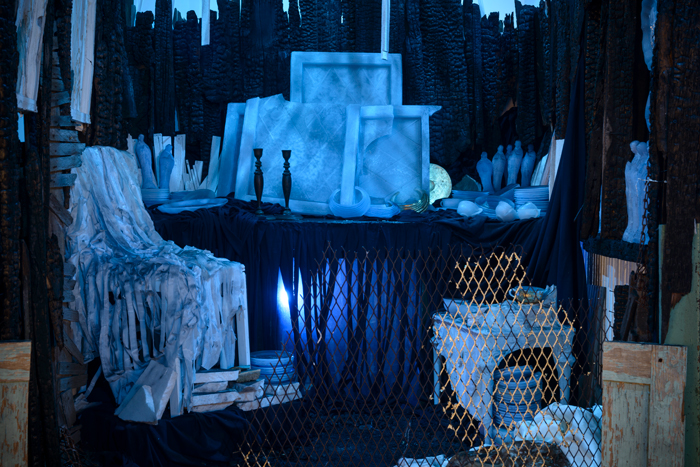
(176”x86”x157”; mixed media installation; 2017). Installation view from the artist’s residency at Red Bull Arts, Detroit. Photo by Shaun Roberts.
In her installations, Julie Schenkelberg, who was born in Cleveland and lives in Detroit, also uses a wide array of found objects she has scavenged from dilapidated neighbourhoods, drawing upon ruins of her hometown and other cities she to which she has personal connection. Her elaborate assemblage process includes raw material such as metal from condemned buildings, chairs from scrap yards, and vintage mouldings from homes, which are altogether associated with past industrial history, its fall, and the beauty of the surrounding landscape.
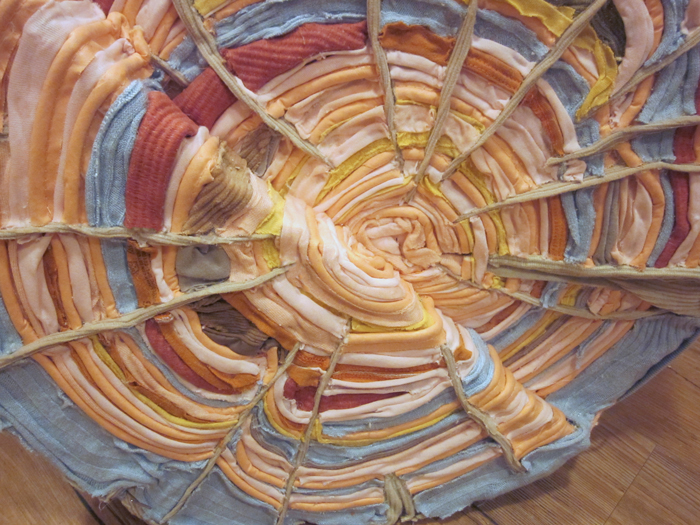
19″x20″x32″; discarded clothing; 2018. Photo by Roni Mocan.
Tamara Kostianovsky assembles in her immersive installations found objects that are loaded with biographical intimacy within a wider political context. Kostianovsky mainly uses discarded clothes and upholstery as a surrogate for the body, “a type of second skin”, as she puts it. Kostianovsky, who was born in Israel, grew up in Buenos Aires, and lives in Brooklyn, says that her practice originated at a time when she was awaking to the work of women artists who used their bodies as “material”.
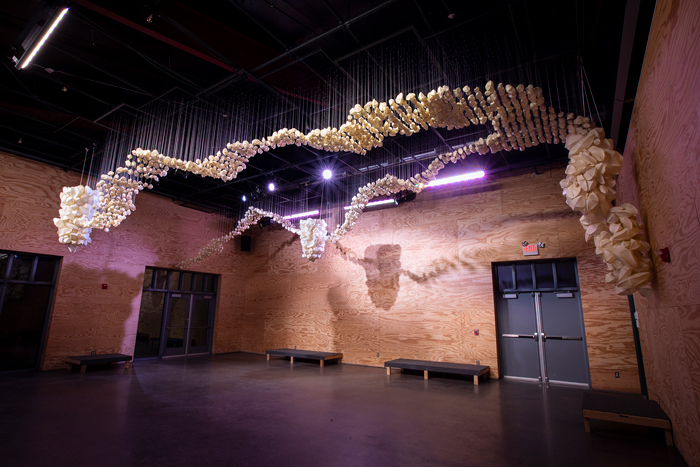
6’9.75”x36’x54’, suspended 9’6” above stage floor; 2018. Photo by Jon Reis Photography
Lorrie Fredette’s monochromatic structures are produced by hand in a factory-like manner with an affinity to Post-Minimalism. Fredette, who was born and raised in a small suburb of Boston, works with a defined selection of materials and multitudes of determined forms with minimal variations. Each of her pod-like elements begins with a hand-formed armature she calls a “skeleton”. She emphasizes that her process is all done by hand with step-by-step precision. First she solders, then fits and sews unbleached cotton muslin to the form, and finally, each pod is painted with between seven and nine layers of molten beeswax and tree resin, a material which was historically used to store biological specimens.
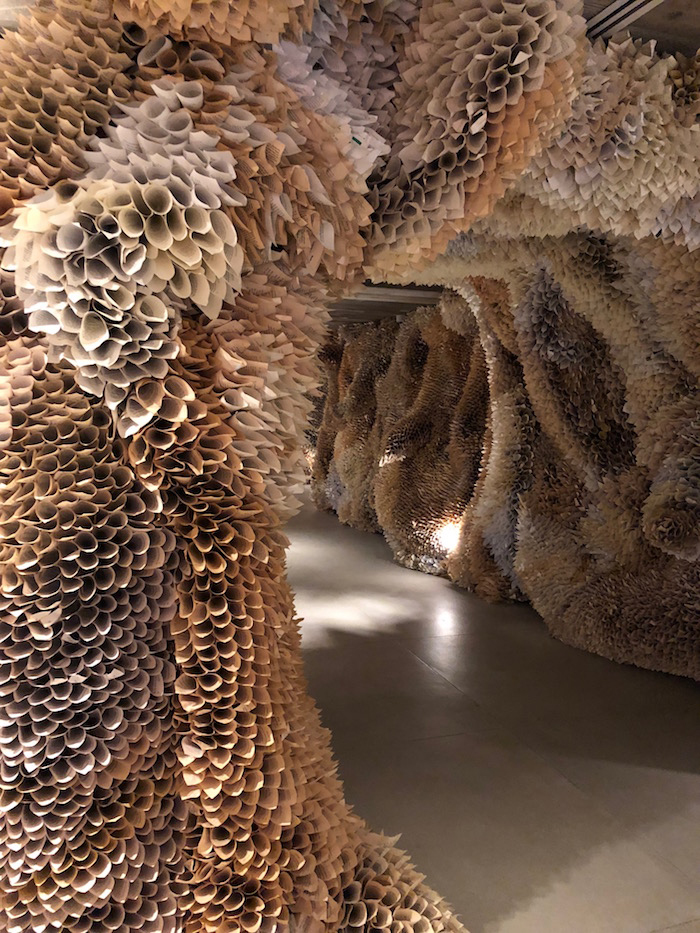
(2400 sq. ft.; installation; 2017). Installation view from Art Basel Miami Beach
Samuelle Green sees her attention to composition during assembly as equivalent to a traditional collage process: “it is about finding shapes and colours that work next to each other on both the micro and macro scale,” she says. In 2011, Green purchased a mid-1800s brick building on Main Street in Honesdale, Pennsylvania, the small town where she grew up. With the help of friends and family, the building was renovated and became her studio space, public art space, and event venue, known as “Basin and Main”. In a way, this cultural hub is an extension of her multidisciplinary practice, the ultimate collage project.
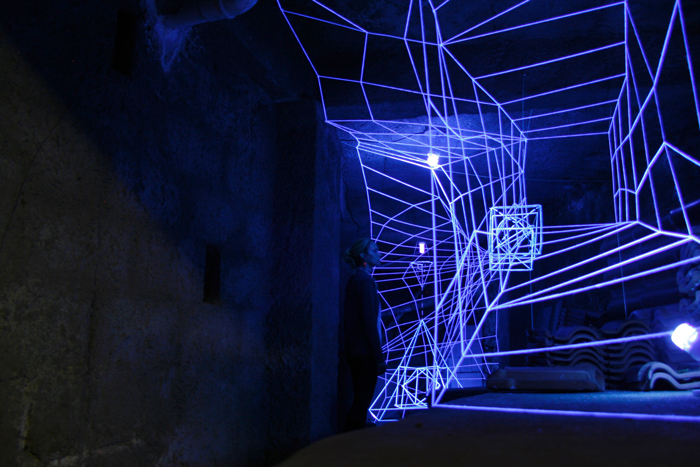
(dimensions variable; strings, fishing wire, wire, UV light; 2018). Installed in an Rio de Janeiro in abandoned bunker built to escape the military dictatorship in Brazil (1964–85)
Sabrina Barrios, who was born and raised in southern Brazil and then lived in London and New York, is a world traveler whose excursions play a central role in her visual world. Her interests are vast, ranging from the physics of time and space, to ancient civilizations and history of the oppressed. Coming from Brazil, her work also has an intrinsic political undertone expressed through questioning the gaps in human history. Barrios started as a traditional collage artist and has been using collage process throughout all her media. The magic in her environments derives largely from her ability to transform mundane objects like strings into complex linear mazes; layered sites where the visitor is prompted to navigate and wonder.
This article appeared in Kolaj #26. To see the entire issue, SUBSCRIBE to Kolaj Magazine or Get a Copy of the Issue.
